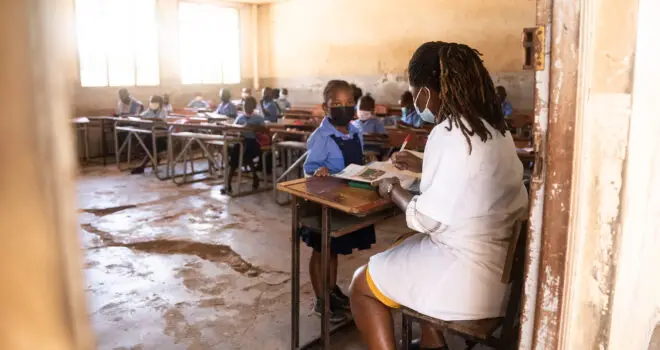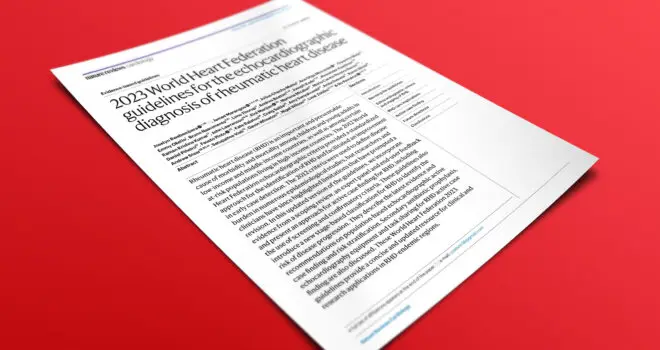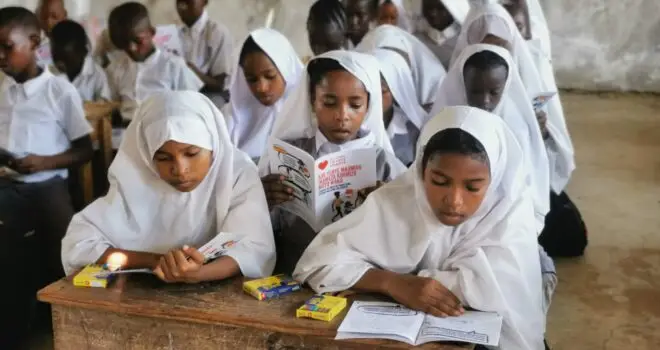Interview on “The Investment Case for the Prevention and Management of Rheumatic Heart Disease in the African Union 2021-2030: a Modelling Study” with co-author Professor Karen Sliwa, Director of the Hatter Institute for Cardiovascular Research in Africa at the University of Cape Town and Past President of the World Heart Federation (WHF).
WHF: What was the rationale for developing this ‘first of its kind’ modelling study?
KS: It was back in January 2017 when I was President-Elect of the World Heart Federation and Chair of the Rheumatic Heart Disease (RHD) Task Force Group. We started mapping the issues to answer the question ‘Why is Rheumatic Heart Disease still so common in Africa?’ We looked into the factors contributing to the burden of disease in Africa and there were two really critical points identified. One was access to penicillin as a tool to prevent Rheumatic Fever and Rheumatic Heart Disease. And the other was access to advanced cardiac care which is the other bottleneck. If you go on to develop RHD, it’s difficult to diagnose without doing cardiac ultrasound and for that, you need dedicated cardiothoracic centres.
WHF: What structural mechanisms were needed to ensure a robust study?
KS: Over a two-year period, we focused on this Rheumatic Heart Disease Task Force, regularly contacting experts including Ana Mocumbi, Associate Professor of Cardiology at Universidade Eduardo Mondlane in Mozambique and Affiliated Professor at the Department of Global Health at the University of Washington as well as Peter Zilla, Head of Christiaan Barnard Department for Cardiothoracic Surgery, University of Cape Town. We focused on looking into the supply of penicillin, ways to use penicillin appropriately, and ways to understand primary care tools better. We started two different projects. One was the “Colours to Save Hearts” which is a colouring book project for kids as well as part of a bigger training initiative to promote awareness and early care. Ana Mocumbi works in Mozambique where we wanted to create more awareness for Rheumatic Heart Disease and children with tonsillitis, encouraging seeking healthcare by going to the primary healthcare clinic early. The other project was to form the inter-cardiac surgical alliance as a special global grouping to create awareness about inadequate access to surgery for people living with Rheumatic Heart Disease in order to form centres of excellence and to improve training for surgeons to do the procedures.
WHF: How did these projects and the overall work evolve to become this compelling study?
KS: Two years later when both of the above projects were underway, I got to thinking: “On what are we actually basing our interventions and our projects to really understand the cost implications of doing such projects?” I’ve been living in Africa for 30 years and very much aware that there are many healthcare challenges here, and there is a long wish list. In the end, you can really only do a number of things and you look for those things with the biggest impact because there is a certain “pot” that has to be shared with issues such as HIV, tuberculosis, now COVID, and many other factors.
So that’s when I thought: ‘let me start from scratch and actually look at cost implication of primary prevention.’ And secondly, we integrated secondary and tertiary prevention as a separate costing to understand those implications. Also, I fully believe that to convince ministers of health, ministers of finance and ministers of education to implement such programs, you need figures as they want to see the costs. So that’s where the project started and it was commissioned with the Health Economic Unit in Boston, with Matthew Coates from the Department of Medicine at Brigham and Women’s Hospital.
WHF: Can you describe for us some key steps in approach or methodology to get the data that would allow for analyzing the costs and benefits then?
We had at least ten meetings to map what we are costing and we created very detailed lists where I gave major input based on my experience living and working in Africa. We took into consideration the cost of care provision, visiting primary healthcare clinic on a monthly basis and we arrived at various models. Initially the primary prevention was even more costly as it is in the publication— and actually, after downsizing the cost by virtually lowering the salaries of the healthcare workers and assuming they can see a particular large number of kids per day for the penicillin injections that we came to the currently published numbers. So, the primary prevention cost is definitely not inflated but perhaps more the contrary. Both the finding and the analysis are actually quite well shown on Table 2 of the Stud.
Primary prophylaxis, that is, health center-based pharyngitis treatment the cost includes paying for the nurse at the clinic and for penicillin.
For the secondary and tertiary costs we calculated the expenses for the relatively small group of patients that developed from throat infection to Rheumatic Fever, and whose valves were severely affected and who developed the disease.
We calculated the costs to diagnose them, manage the heart disease with medication and those who need surgery, get the surgery.
Doing this, we could show the RHD deaths that can be avoided per thousand. You can see that with primary prophylaxis the figure is 0.8, so less than one per thousand deaths versus 59.5, which is sixty deaths per thousand if you do the integrated secondary and tertiary care.
WHF: Can you tell us more about the different options in cost-benefit terms?
KS: If you do the integrated tertiary care, there is a big difference in reduction of deaths. And then if you look at the full income benefit, so the benefit of the money you spend versus the money you save per death, there is also a big difference of full income benefit of 0.5 dollars versus 4.5. Then if you look at the cost-benefit ratio, it would be one-tenth if you do the primary prevention versus secondary integrated care.
Ideally, you could consider everything. And there will be some countries who can do everything because they have the financial resources. I that think happened in Tunisia because it’s a relatively wealthy country in Northern Africa with a relatively small population, a relatively well-educated and relatively wealthy population. I think that all intervention projects are ideal for a country like Tunisia who can afford it and has a population with wide access. They have primary care clinics where everything can be done, including surgery.
WHF: So, tell us what struck you as you considered these different care interventions?
KS: I thought ‘Why is there such a big difference in primary prevention versus secondary and tertiary?’ Because intuitively, prevention, as is the case for many other diseases, is cheaper than addressing eventual complications. With high blood pressure and diabetes, well, early treatment is cheaper than treating strokes, kidney disease and heart attacks. But if you have high blood pressure or diabetes and you don’t treat it at all, 10 years later, at least one-third of the patients develop serious disease. If you take a 40-year old with very high blood pressure and you don’t act, one-third of them will either have a heart attack or develop kidney disease. If you have a child with Rheumatic Fever, one in a thousand develop heart disease.
With tonsillitis, less than one in thousand gets Rheumatic Fever and of those who do, less than a hundred get significant heart disease needing medication or surgery. The probability of having a trigger like streptococcal infection leading to a significant heart problem is very different than with diabetes and hypertension leading to the same. This underscores the benefit of primary prophylaxis and explains why primary, secondary and tertiary care are so different in Rheumatic Heart Disease.
WHF: What about regional factors and local conditions and applying these interventions including in your own country of South Africa?
KS: Another big factor which comes into play is disease prevalence. So in a country like Mozambique where there is still a lot of Rheumatic Fever because of overcrowding and poverty, and fewer surgeons, it is still advisable to do primary prophylactic care or prevention.
In a country where the disease is becoming relatively rare because of increased affluence and less overcrowding, it might be less cost-effective to do the primary preventive care and better to focus instead on treating the cases. I can say for South Africa, because I work here, I have not seen a child or an adolescent with Rheumatic Fever in the past 10 years. It’s rare here because South Africa is a middle-income country. We have kids with throat infections who get antibiotics. South Africa has good surgeons and good cardiologists. For South Africa, or most of the country, the most likely model then is integrated secondary and tertiary care but you can also do it by province. The Eastern Cape is a poor province so there, one can do interventions at all levels but for the rest of the country, I would advise integrated secondary and tertiary care only. It is important to understand the costs of interventions and the respective healthcare systems in order to apply what is affordable, but also to factor in disease frequency in looking at the best model for your country. And I think for that, the study is highly important along with its analysis.
WHF: What are your biggest hopes and ideal next steps now that this work has come to fruition and is being published?
KS: I hope leaders in healthcare will look at Table 2 of the study and use the data wisely for their own country to avoid patients getting Rheumatic Heart Disease and to ensure the best possible care for those who do. Data gives us the information we need and equips us to use it appropriately.


